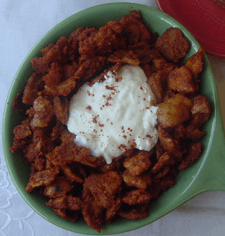Eritrean cuisine

Eritrean cuisine is a fusion of Eritrea's native culinary traditions, and the area's long history of trade and social interchanges with other regions and cultures.
Overview
The main traditional food in Eritrean cuisine is tsebhi (stew), served with injera (flatbread made from teff, wheat, or sorghum), and hilbet (paste made from legumes; mainly lentil and faba beans). Eritrean and Ethiopian cuisine (especially in the northern half) are very similar, given the shared history of the two countries.
Eritrean cuisine strongly resembles those of neighboring Ethiopia and Somalia,[1][2] except for the fact that Eritrean and Somali cooking tend to feature more seafood than Ethiopian cuisine on account of their coastal locations. A typical dish consists of injera accompanied by a spicy stew, which frequently includes beef, kid, lamb or fish.[2] Eritrean dishes are also frequently "lighter" in texture than Ethiopian meals. They likewise tend to employ less seasoned butter and spices and more tomatoes, as in the tsebhi dorho delicacy. Additionally, owing to its colonial history, cuisine in Eritrea features more Ottoman and Italian influences than are present in Ethiopian cooking, including more pasta specials and greater use of curry powders and cumin.[3] People in Eritrea likewise tend to drink coffee, whereas sweetened tea is preferred in Somalia.[2] Christian Eritreans also drink sowa (a bitter fermented barley) and mies (a fermented honey beverage),[4] while Muslim Eritreans abstain from drinking alcohol.[5]
Common foods and dishes
Eritrean food habits vary regionally. In the highlands, injera is the staple diet and eaten daily among the Tigrinya. When eating, diners generally share food from a large tray placed in the centre of a low dining table. Numerous injera are layered on this tray and topped with various spicy stews. Diners break into the section of injera in front of them, tearing off pieces and dipping them into the stews.
The stews that accompany injera are usually made from beef, chicken, mutton or vegetables. Most Eritreans, with the exception of the Saho, like their food hot and spicy. Berbere, a spice mixture that consists of a variety of common and unusual herbs and spices, accompanies almost all dishes. Stews include zigni, which is made of beef; dorho tsebhi, which is made of chicken; alicha, which is a vegetable dish made without berbere; and shiro, a purée of various legumes.
In the lowlands, the main dish is akelet (also known locally as ga'at), a porridge-like dish made from wheat flour dough. A ladle is used to make an indentation in the dough, which is then filled with berbere, butter sauce and surrounded by milk or yogurt. When dining, a small piece of dough is dipped into the berbere and the butter sauce, and then plunged into the milk or yogurt.
Influenced by its past as an Italian colony, Eritrean cuisine also features unique interpretations of classic Italian dishes.[6] Among these specialties are pasta sauces spiced with berbere.[7]
Beverages

Sowa is the name for the home-brewed beer common in Eritrea. It is made from roasted corn, barley and other grain and is flavored with gesho, a type of buckthorn leaf. The beverage is often made for celebrations; a sweet honey wine is also commonly served. The coffee ceremony is one of the most important and recognizable parts of Eritrean and Ethiopian cultures. Coffee is offered when visiting friends, during festivities, or as a daily staple of life. If coffee is politely declined, then tea (shahee) will most likely be served.
See also
References
- ↑ Tekle, Amare (1994). Eritrea and Ethiopia: From Conflict to Cooperation. The Red Sea Press. p. 142. ISBN 0932415970.
- ↑ 2.0 2.1 2.2 Pamela Goyan Kittler, Kathryn P. Sucher, Marcia Nahikian-Nelms (2011). Food and Culture, 6th ed.. Cengage Learning. p. 202. ISBN 0538734973.
- ↑ Carman, Tim (9 January 2009). "Mild Frontier: the differences between Eritrean and Ethiopian cuisines come down to more than spice". Washington City Paper. Retrieved 12 March 2013.
- ↑ Eritrea: Travel Trade Manual. Ministry of Tourism of Eritrea. 2000. p. 4.
- ↑ "Eritrea - Country Profile". Defense Language Institute Foreign Language Center. Retrieved 17 November 2013.
- ↑ "Man Bites World, Day 64: Eritrea". March 2009. Retrieved 2009-03-22.
- ↑ "Mu'ooz Eritrean Restaurant menu". March 2009. Retrieved 2009-03-22.
External links
| ||||||||||||||
| |||||||||||||||||||||||||||||||||||||||

.svg.png)